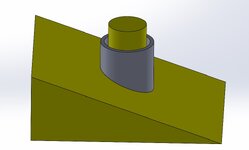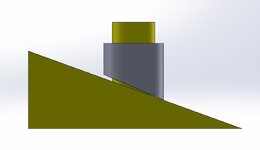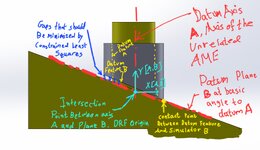sendithard
Industrial
- Aug 26, 2021
- 186
In this mock example I have a yellow fixture with a cylindrical boss as Datum A, then an inclined Datum B at 20 deg Basic. We slip the gray part over Datum A which let's just say expands b/c it is at RFS, so Datum A is locked in solid.
'
I don't think I've seen an example in the standard for an inclined datum B with Datum A as cylindrical.
I simulated the part machined 2 deg wrong just for visual. My intuition says the inclined datum arrests the rotation but I have a software saying rotation is still in play. I disagree.


'
I don't think I've seen an example in the standard for an inclined datum B with Datum A as cylindrical.
I simulated the part machined 2 deg wrong just for visual. My intuition says the inclined datum arrests the rotation but I have a software saying rotation is still in play. I disagree.



